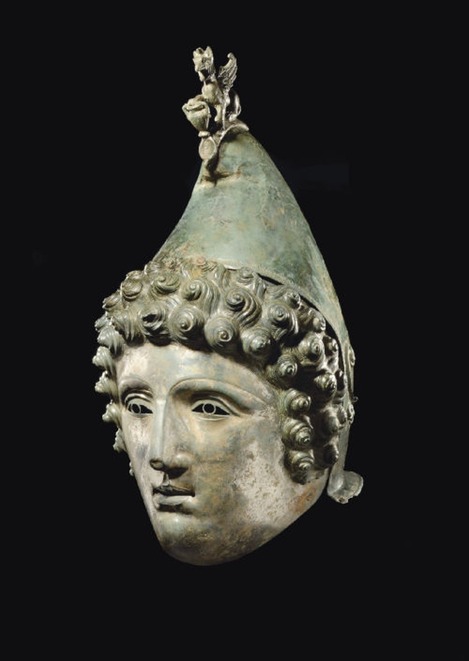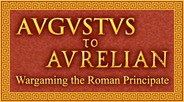
(Photograph courtesy of the Portable Antiquities Scheme)
"The horsemen enter [the parade ground] fully armed, and those of high rank or superior in horsemanship wear gilded helmets of iron or bronze to draw the attention of the spectators. Unlike the helmets made for active service, these do not cover the head and cheeks only but are made to fit all round the faces of the riders with apertures for the eyes…" (Arrian, ars tactica 34)
First of all, before I get started, an apology - this isn't really a wargaming post, but it is related, through my interest in Roman (military) history and archaeology.
A few days ago I hopped on a train to Carlisle, to go and take a look at the (in?)famous Crosby Garrett helmet. I have recently bought, for the princely sum of five pounds, the booklet on the helmet edited by Mike Bishop and David Breeze and published for the Tullie House Museum's exhibition of the helmet. It is worth buying, for the pictures as much as anything, though the story it tells is annoyingly incomplete - unsurprisingly, given the helmet's apparent story. It is also surprisingly unquestioning/accepting of some of the 'odder' parts of the helmet's tale.
The helmet, as restored and presented, is a beautiful artefact. It is, however, highly controversial - a quick search on Google for phrases like "Crosby Garrett Helmet Fake" will reveal a plethora of opinion on the helmet, its finding, restoration and sale at auction. I could rant for ages about the ethics of metal detectorists, treasure hunting, and the inadequacies of Britain's laws on treasure when faced with a single object made of base metal which is, nevertheless, virtually priceless - simply by virtue of the information that, if its recovery and restoration had been handled correctly, could have been gleaned. Rather than repeating all the arguments here, I shall leave it to you, gentle reader, to employ your own 'Google-fu' and form your own opinion.
The 'object' seems to have been discovered as a collection of almost seventy fragments, and subsequently 'restored' (or remade?) by a private restorer who allegedly spent 240 hours on the task - unfolding, straightening, fitting, gluing, filling and then applying a 'patina of age'. He did a fine 'artistic' job, but is the helmet as presented really representative of what was found, and how does it relate to what was buried all those centuries ago? There really is no way to tell - the restoration is so 'perfect' that, in the words of Eric Morecambe describing Ernie Wise's wig, "you can't see the join" - so there is no opportunity to employ one's own critical faculties.
Six working weeks seems like a remarkably short time in which to make a 'proper job' of such a complex task. And, personally speaking, I would have far preferred to see a 'restoration' more like that on the Ribchester helmet, which leaves you in no doubt that the object has been dug out of the ground with significant damage, but still allows you to get a good feel for how it must have looked when new. But presumably then the object would not have sold for £2.3 million. The restoration can be said to have achieved its purpose - that of making the finders and landowner a lot of money.
Leaving aside all the controversy over the helmet's finding, restoration and sale, and returning to the object itself, what can we say? The mask (which really ought to be called the 'front half' of the helmet, for that is what it is) was found almost intact (a chunk of chin and one and a bit curls of hair were missing). The face, whilst different in detail, has the 'usual' beautiful, somewhat 'other-worldly', appearance. It appears to be very thin - like the rest of the helmet - and thereby clearly not 'battle-worthy', but intended instead purely for show. The helmet 'bowl' is (at least after reassembly - which seems to have involved a fair amount of metal-bashing and quite a lot of filler) of 'Phrygian' form, with an odd little griffin on top, supporting an amphora. The helmet is decorated with a series of finely engraved, stylised, flowers - or are they stars - or fireworks?
Enough Roman cavalry helmets have been found for the archaeologists to have come up, as they are wont to do, with a classification system. Some, like the Crosby Garrett example, are clearly too delicate to have been intended for anything but show. Some others though, seem more substantial - indeed some seem to be more or less ordinary cavalry helmets, with the addition of a mask - presumably the (later) 'cavalry sports' helmets evolved from these examples.
One of the earlier examples of these masks was found on the battlefield of Kalkriese - the site of the so-called 'Varian Disaster' (or Battle of the Teutoberg Forest) where the Roman general Publius Quinctilius Varus lost three legions to a horde of Germanic barbarians led by Arminius. This particular mask, like some others, was of iron manufacture, with a decorative covering of silver, and so could conceivably have been worn in the battle. As well as providing a modicum of protection, it would have made its wearer appear considerably more imposing, with an inscrutable, expressionless, silver visage. So there's no reason why the odd figure in Roman cavalry regiments in your wargames armies shouldn't be depicted with a face-mask, but I would steer clear of going for one of the really fancy helmets - like the Crosby Garrett example.
Finally, I can't help but feel that there's something distinctly 'rum' about the whole business - so much so that I am a little wary... Is this eventually going to turn out to have been an elaborate hoax like Piltdown man?
